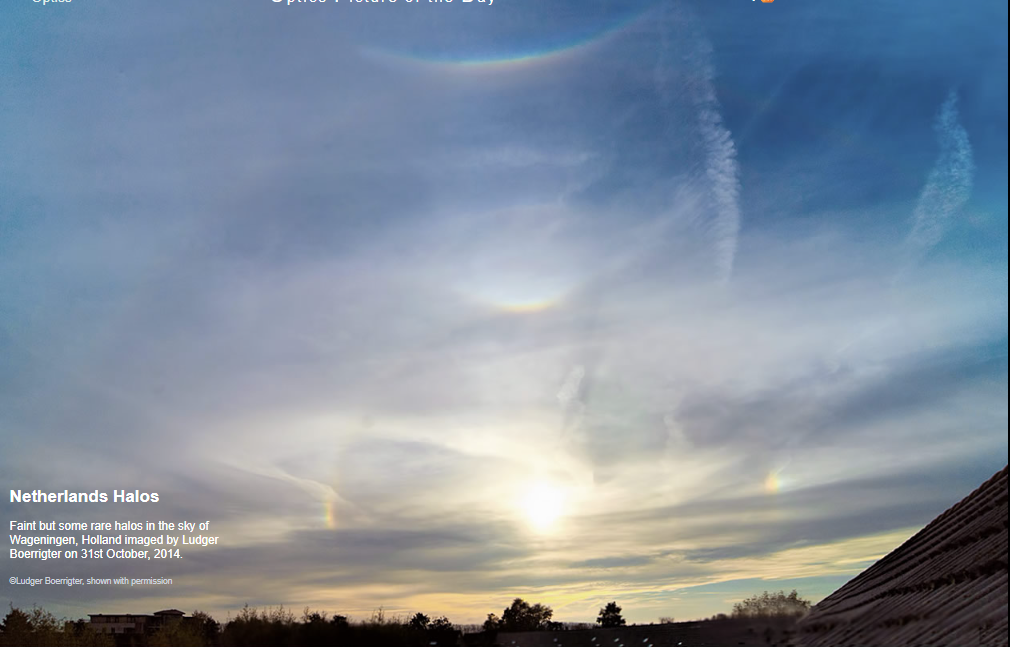Netherlands Halo Display - OPOD
Netherlands Halo Display - OPOD: A Rare Atmospheric Phenomenon
The Netherlands is known for its picturesque landscapes and beautiful skies. However, on the 31st of October, 2014, the sky above Wageningen in Holland treated onlookers to a rare and captivating display of halos. Ludger Boerrigter, an avid skywatcher, captured these faint yet remarkable halos in a series of stunning images.
Halos are optical phenomena that occur when light interacts with ice crystals suspended in the atmosphere. These crystals act as tiny prisms, bending and refracting light to create a variety of intriguing optical effects. While halos are not uncommon, witnessing such a display in the Netherlands is a rare treat.
The halos observed in the Wageningen sky on that fateful day showcased the complexity and beauty of atmospheric optics. Ludger Boerrigter's images captured the imagination of sky enthusiasts worldwide, prompting further exploration and analysis of this exceptional event.
The Nature of Halos
Halos are formed when sunlight or moonlight passes through ice crystals in the atmosphere. These crystals can take various shapes, including hexagonal columns or plates. As light enters these crystals, it undergoes refraction and reflection, resulting in the formation of intricate patterns in the sky.
The specific halo display witnessed in the Netherlands involved several types of halos, each with its own distinct characteristics. Some of the halos observed included:
- Circumzenithal Arc (CZA): This halo forms an upside-down rainbow-like arc positioned above the sun. It is often vibrant and displays vivid colors.
- Supralateral Arc: This halo is similar to the circumzenithal arc but extends horizontally from the sun.
- Parhelic Circle: This halo forms a complete circle around the sun, intersecting with sundogs (bright spots on either side of the sun).
- 22-Degree Halo: This halo is a circular ring around the sun or moon, positioned at an angle of approximately 22 degrees.
Atmospheric Conditions for Halos
For halos to occur, specific atmospheric conditions must align. Firstly, there must be the presence of ice crystals at high altitudes. These crystals can originate from the freezing of supercooled water droplets or from the sublimation of ice directly from the air. Secondly, sunlight or moonlight must be present to illuminate these ice crystals and create the optical effects.
Furthermore, the orientation and alignment of the ice crystals play a crucial role in determining the shape and appearance of the halos. Hexagonal ice crystals are particularly effective at producing well-defined halos due to their symmetry and ability to refract light at specific angles.
Unraveling the Mystery
The Netherlands halo display captured by Ludger Boerrigter sparked curiosity among atmospheric optics enthusiasts and researchers alike. The unique combination of halos observed in this event provided an excellent opportunity for further investigation into the mechanisms behind these optical phenomena.
Scientists and researchers examined the meteorological conditions leading up to the halo display, studying factors such as temperature, humidity, and cloud formation. They also analyzed the crystallographic properties of the ice crystals present in the atmosphere during this event.
Through careful analysis and comparison with existing atmospheric models, scientists aimed to gain a deeper understanding of the complex interplay between sunlight, ice crystals, and atmospheric conditions that give rise to such mesmerizing displays.
The Importance of Citizen Science
Events like the Netherlands halo display highlight the value of citizen science in advancing our knowledge of atmospheric optics. Sky enthusiasts, armed with cameras and a passion for observing the skies, can capture rare phenomena that might otherwise go unnoticed.
By sharing their images and observations with the scientific community, citizen scientists contribute valuable data that can enhance our understanding of atmospheric phenomena. In the case of the Netherlands halo display, Ludger Boerrigter's images provided researchers with a unique dataset to study and analyze.
A Reminder of Nature's Splendor
The Netherlands halo display serves as a reminder of the wonders that can be found in the natural world. Atmospheric optics offers a glimpse into the intricate workings of our atmosphere, showcasing the beauty and complexity that can arise from the simplest of natural phenomena.
While rare halo displays like the one witnessed in the Netherlands may be infrequent, they serve as a testament to the perpetual surprises that nature has in store for us. By keeping our eyes to the sky and embracing the marvels of atmospheric optics, we can continue to uncover the secrets of our ever-fascinating atmosphere.

Netherlands Halos
Faint but some rare halos in the sky of Wageningen, Holland imaged by Ludger Boerrigter on 31st October, 2014.
©Ludger Boerrigter, shown with permission

Note: this article has been automatically converted from the old site and may not appear as intended. You can find the original article here.
Reference Atmospheric Optics
If you use any of the definitions, information, or data presented on Atmospheric Optics, please copy the link or reference below to properly credit us as the reference source. Thank you!
-
<a href="https://atoptics.co.uk/blog/netherlands-halo-display-opod/">Netherlands Halo Display - OPOD</a>
-
"Netherlands Halo Display - OPOD". Atmospheric Optics. Accessed on November 26, 2024. https://atoptics.co.uk/blog/netherlands-halo-display-opod/.
-
"Netherlands Halo Display - OPOD". Atmospheric Optics, https://atoptics.co.uk/blog/netherlands-halo-display-opod/. Accessed 26 November, 2024
-
Netherlands Halo Display - OPOD. Atmospheric Optics. Retrieved from https://atoptics.co.uk/blog/netherlands-halo-display-opod/.